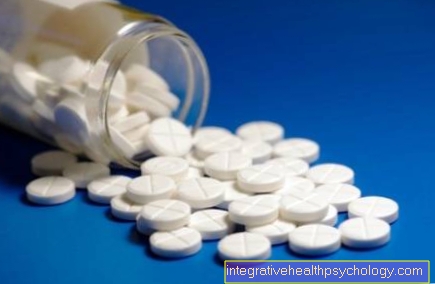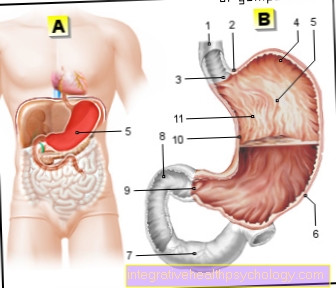Valium®
Synonyms
Diazepam
definition
Diazepam is often better known by one of its trade names: Valium®. It belongs to the group of benzodiazepines, which in turn belong to the psychotropic drugs, i.e. they affect the central nervous system (CNS).
Diazepam is used, among other things, to treat anxiety disorders, for premedication (before operations) and to interrupt a seizure in epilepsy.

effect
Valium® is a Benzodiazepine. It works:
- anxiolytic (anxiety-relieving)
- anticonvulsant (relaxing)
- muscle relaxing (muscle relaxing)
- sedative to hypnotic (dampening)
Valium works on the group of GABA receptors in the brain, which are located on the surface of nerve cells. Here it leads to a dampening of the nerve cell.
The half-life of Valium® is up to 48 hours. Therefore, nowadays, especially when used in patients who are not in hospital treatment, active ingredients from the same group are used more frequently, but with a shorter half-life. The main problem with the long half-life is the overhang. This means that the tablet lingers for a long time. For example, if it was taken in the afternoon or evening of the previous day, those affected are often clearly tired and sleepy the morning after.
Diazepam is used for excitement and anxiety, alcohol withdrawal syndrome and acute epileptic fits. It is also used for insomnia, whereby benzodiazepines, which have a lower risk of overhang, are preferred due to their long half-life.
indication

Benzodiazepines in general often times as well Tranquilizers, so called sedatives. Among other things, they are used to Therapy for anxiety disorders used. They are also used at sleep disorders, where the short-acting benzodiazepines like Triazolam Are used because Valium® (Diazepam) has a half-life that is far too long for this indication and would lead to overhang, i.e. fatigue well into the next day.
Furthermore, Valium® Often given for premedication, i.e. before operations, so here one makes use of its anxiety-relieving and sedating components.
Also as Anticonvulsant (Greek / Latin against seizures) Valium® is used, but not as a standard medication. That depends on the strong one Dependency potential together that benzodiazepines generally hold. It is more likely to be acute here Seizures used to break the spasms, to get the patient out of immediate danger.
pharmacology
As a result of that Valium® - in contrast to most other benzodiazepines - when it is broken down it is converted into substances that do not lose their effectiveness as a result of this conversion, it has a relative effect long half-life of about 40 hours. This makes it one of the long-acting benzodiazepines. For example, short-term effects Triazolam or Midazolam, to the medium-long effective count among others Oxazepam and Lorazepam (Trade name: Tavor®).
Dependency
Benzodiazepines instruct strong potential for dependency on. Therefore, as a rule, they should not last longer than a period of 3-6 weeks administered.
Withdrawal symptoms in the case of addiction can, among other things, make themselves felt in the form of Anxiety, Hypersensitivity and hallucinations.
Can you buy Valium® without a prescription?
Valium® is one of the psychotropic drugs. It contains the active ingredient diazepam. This is a drug from the group of benzodiazepines. Valium® cannot be purchased without a prescription. This is mainly due to the fact that the active ingredient has a strong effect and can have dangerous consequences for patients who have not been instructed in its use. For example, no active participation in road traffic should take place after the drug has been taken. Taken in higher doses, it can lead to pronounced drowsiness and breathing disorders.
A combination with depressant substances such as alcohol or sleeping pills is strictly prohibited due to the risk of life-threatening interactions. Long-term use leads to the development of dependency.
Valium® and alcohol - are they compatible?
No - Since the group of benzodiazepines has a strong depressant effect that arises via GABA receptors in the brain, the combination with alcohol is contraindicated. This has to do with the fact that alcohol and benzodiazepines work on the same type of receptor in the brain, a subtype of the GABA receptor. The binding of alcohol breakdown products or active substances such as diazepam to these receptors leads to an increased influx of ions into the nerve cell concerned. This causes the cell to become less active and the central nervous system is dampened. Since alcohol and diazepam have a very similar effect, there is a significant increase in the effect of both substances when taken at the same time.
It can lead to breathing disorders up to respiratory arrest and comatose states. An overdose of benzodiazepines and alcohol can be fatal. The amount of an overdose varies greatly from person to person. The combination of benzodiazepines and sleeping pills or other depressant substances is also contraindicated.
withdrawal
Benzodiazepines are a very effective drug, especially for treating acute anxiety or agitation. However, the disadvantage of this group of active ingredients is their high potential for dependence.
The dependence can develop after a short time and even with a normal dose. Many patients therefore suffer from benzodiazepine addiction, often without even realizing it. The addiction is psychological and physical in nature. So with withdrawal there are physical and psychological withdrawal symptoms.
Due to the high risk of developing addiction, the intake of Valium® and co should generally be limited to a few weeks. In practice, however, this is often not the case. If there has been a development of dependency, it must be discussed with the person affected how to proceed. As a rule, withdrawal should be sought if the underlying disease allows it. The principle here is not to stop taking the drug completely overnight, but to slowly taper it off, i.e. to keep reducing the dose. Depending on the level of the dose, you can reduce it relatively quickly at the beginning. For example, the dose is reduced at weekly intervals.
Especially towards the end, however, those affected sometimes show pronounced withdrawal symptoms, so that the reduction here should take place very slowly.
The aim is to permanently and completely discontinue the drug. Symptoms of withdrawal include Anxiety, restlessness, mood swings, nightmares, sleep disorders, sweating, poor appetite, nausea, visual disturbances such as flickering eyes or blurred vision, changes in the sense of smell and taste, hypersensitivity to light and noise, tinnitus, tremor (tremors in the hands), palpitations and increased blood pressure. Severe withdrawal symptoms include Hallucinations, fear or belief that they will be followed, seizures, and delirium.
Side effects
To the common side effects Valium® include severe daytime sleepiness, extended reaction time (dangerous in Road traffic!), Dizziness, gait disorders, muscle weakness, concentration disorders, headaches, confusion and the occurrence of temporary memory gaps.
Less common side effects are gastrointestinal complaints (nausea, diarrhea, constipation, vomiting), lack of urine output (urinary retention), chest pain, low blood pressure and low pulse, depressive moods, loss of libido (decrease in sexual desire), menstrual cycle disorders in women, increased appetite, dry mouth , allergic skin reactions (redness, itching), visual disturbances, depressive mood and hallucinations.
Straight in the elderly a so-called paradoxical reaction can occur when taking Valium®. The medication does not make the patients calmer, but rather restless, excited and anxious.
In too high a dosage Valium® can lead to impaired breathing, especially in combination with alcohol, sleeping pills or other depressant substances. In laboratory tests, the use of diazepam can lead to an increase in liver values, which should be monitored. If the liver values increase significantly, it may be necessary to discontinue the drug.
Learn more about it: Side effects of Valium®
Mechanism of action

Valium® (Diazepam) acts on a receptor im brain. This receptor sits on nerve cells and regulates the influx of through its coupling to a channel Chloride ions into the cell.
Such channels are necessary because the cell is otherwise quite impermeable to ions of any kind. Only through the presence of pumps, channels and receptors (which are often linked to channels) ions can get from the inside of the cell to the outside or from the outside into the inside of the cell. If this were not the case and the ions could each freely choose their gradient (thus from the place of the higher to the place of the lower concentration of yourself), the cell would shrink or burst as a result of the subsequent osmotic (equalizing) flow of water and thus become inoperable.
The receptor to the Valium® (Diazepam) is called GABA receptor designated. GABA (Gamma aminobutyric acid) is a Neurotransmitters. He is the ligand for this receptor. This means that when GABA binds, the receptor does one Conformational change through and the channel that belongs to the receptor complex for a few milliseconds permeable to chloride ions. Since the chloride concentration outside the cell is much higher than inside, chloride ions flow into the cell interior in this short phase of the open channel. Chloride ions are simply negatively charged. So the cell gets a more negative potential through its influx.
If you delve a little deeper into cell physiology, you see as a law that a cell always becomes more active when its potential becomes more positive. The normal resting potential a cell is in the range between -60 and -80 mV (Millivolts). When negative ions flow out or positive ions flow in, the potential of the cell approaches 0 (Depolarization). If it has reached a certain threshold, an action potential arises and the cell is excited, i.e. active. But it is the other way around with the influx of negative charge, as in the case of the GABA receptor. Chloride ions flow in, so the potential of the cell becomes even more negative. The cell is hyperpolarized. This makes it even less excitable, so it would take a lot more “effort” to get it into an active state.
Now what is the effect of Valium®? It binds to the GABA receptor and changes its conformation in such a way that it becomes even more susceptible to the binding of its GABA ligand. A hyperpolarizing chloride influx occurs more quickly and easily and the cell becomes less excitable.





























